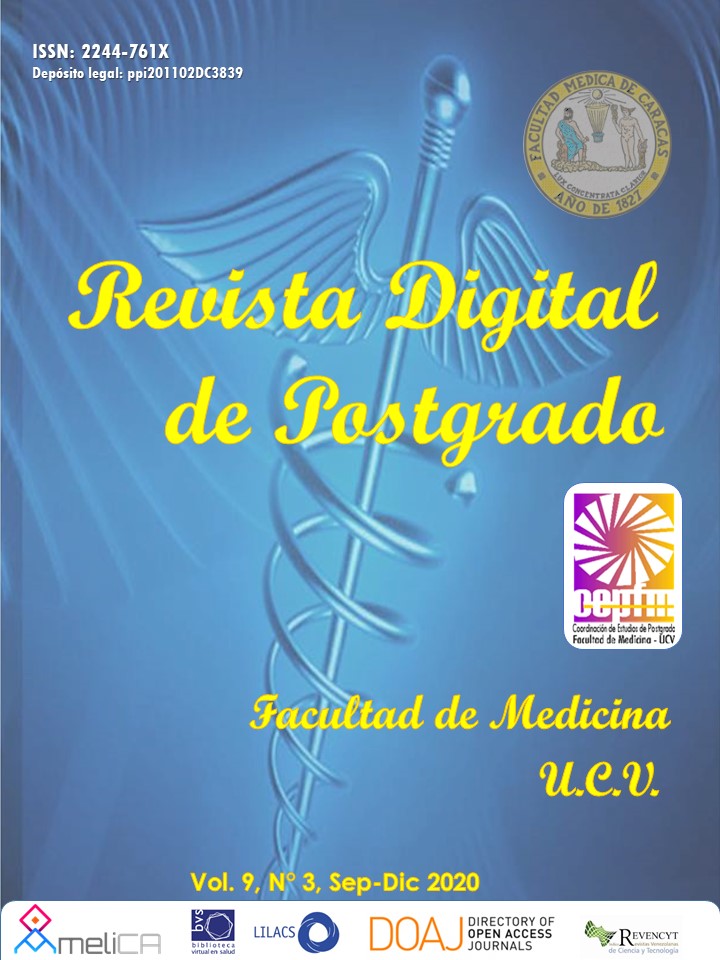Importance of the socio-demographic and epidemiological characteristics, in the management of ovary tumors
Keywords:
ovarian tumor, socio-demographic characteristics, epidemiological characteristics, Clinico-pathological characteristics. INTRODUCCIÓNAbstract
Abstract: Objective: To describe the main socio-demographic and epidemiological characteristics of patients with ovarian tumors. Methods: Descriptive, cross-sectional study, with a population of 133 patients who attended the Oncology Gynecology clinic of the Hospital Oncology Service of the IVSS, between July 2016 and July 2017, with diagnosis of ovarian tumors, where only 24 complied with the inclusion criteria. Results: Of the 133 patients who attended the Oncology Gynecology clinic with a diagnosis of ovarian tumors, only 24 patients met the inclusion criteria. Highest origin Miranda State with 42%. The 46% mixed race. The average age 48.33 years. Average menarche 12.29 years. Average sexarchy of 19.14 years. Sexual couples between 1-2, 46%. Obstetric history: 2.5 pregnancies. Oral contraceptives 21%. Intrauterine devices in 21%. Smoking habit 29%. Symptoms in 83% (58% increase in abdominal volume) with evolution of 4.05 months. 63% benign tumors (mucinous cystadenoma with 46%), 33% malignant tumors (endometroid adenocarcinoma with 37%) and 4% borderline (atypically proliferative), the type (mucinous). According to the FIGO stage 1C and 3C classification with 38% respectively. The predominant laterality on the right side (54%). The average size was 17.60 cm. Conclusion: The socio-demographic, epidemiological and clinical-pathological characteristics determine the proper management of ovarian tumors, so they must be thoroughly investigated, and thus offer the best individualized treatment to patients.Downloads
References
Dubeau L. The cell of origin of ovarian epithelial tumours. Lancet Oncol. 2008; 9(12):1191-1197.
Kurman RJ, Seidman JD, Shih IM. Serous borderline tumours of the ovary. Histopathology. 2005; 47: 310-318.
Torre L, Farhad I, Siegel R, Ward E, Ahmedin J. Global cancer in women: burden and trends. American Association for Cancer Research. 2017; 23
Berek J, Crum C, Friedlander M. Cancer of the ovary, fallopian tube, and peritoneum. FIGO International Journal of Gynecology and Obstetrics. 2015; 131: 111-22.
International Federation Of Gynecology And Obstetrics FIGO. Report on the result of treatment in gynecological cancer. Int. J. Gynecol. Obstet [Internet]. 1987; [citado el 12 de agosto de 2017]; 25, 87-8. Disponible en: https://ejgo.org/search.php?where=aview&id=10.3802/jgo.2008.19.4.223&code=1114JGO&vmode=REF.
Kurman RJ, Shih IeM. The origin and pathogenesis of epithelial ovarian cancer: a proposed unifying theory. Am F Surg pathol. 2010;34(3): pág. 433-443.
Barber H. Embriology of the gonad whith reference to special tumors of the ovary and testis. J Ped Surg. 1988; 23: 967-972.
Stany MP. Maxwell GL, Rose GS. Clinical decision making using ovarian cancer risk assessment. AJR Am J Roentgenol. 2010; 194(2):337-342.
The World Health Organization (WHO) Collaborative Study of Neoplasia and Steroid Contraception. Depot-medroxyprogesterone acetate (DMPA) and risk of epithelial ovarian cancer.Int J Cancer. 1991; 49: 191-195.
Jick SS, Walker AM, Jick H. Oral contraceptives and endometrial cancer. Obstet Gynecol. 1993; 82: 931-935.
Goff. BA, Mandel L, Muntz HG, Melanco CH. Ovarian carcinoma diagnosis-results of a national ovarian cancer survey. Cancer. 2000; 89: 2068-2075.
Goff. BA, Mandel L, Muntz HG, Melanco CH. Frequency of symptoms of ovarian cancer in women presenting to primary care clinics. JAMA. 2004; 291: 2705-2712.
Women`s Cancer Network. Ovarian Cancer Symptoms Concensus Statement. [Internet] 2012; [Consultado 20 de mayo de 2020] Disponible en http://www.wcn.org/articles/types_of_cancer/ovarian/symptoms/concensus_statement.html.
Valentin L. Use of morphology to characterize and manage common adnexal masses. Best Pract Res Clin Obstet Gynaecol. 2004; 18:71-89.
How to Cite
Issue
Section
License
Usted es libre de:
- Compartir — copiar y redistribuir el material en cualquier medio o formato
- Adaptar — remezclar, transformar y construir a partir del material
- para cualquier propósito, incluso comercialmente.
Bajo los siguientes términos:
-
Atribución — Usted debe dar crédito de manera adecuada, brindar un enlace a la licencia, e indicar si se han realizado cambios. Puede hacerlo en cualquier forma razonable, pero no de forma tal que sugiera que usted o su uso tienen el apoyo de la licenciante.
- No hay restricciones adicionales — No puede aplicar términos legales ni medidas tecnológicas que restrinjan legalmente a otras a hacer cualquier uso permitido por la licencia.











